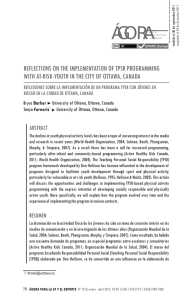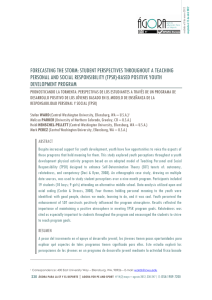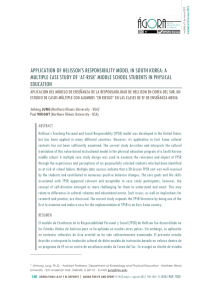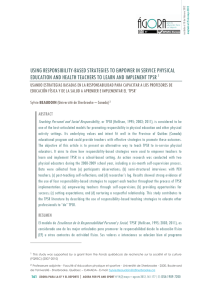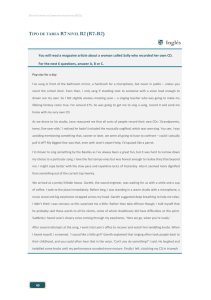teaching personal and social responsibility through secondary
Anuncio
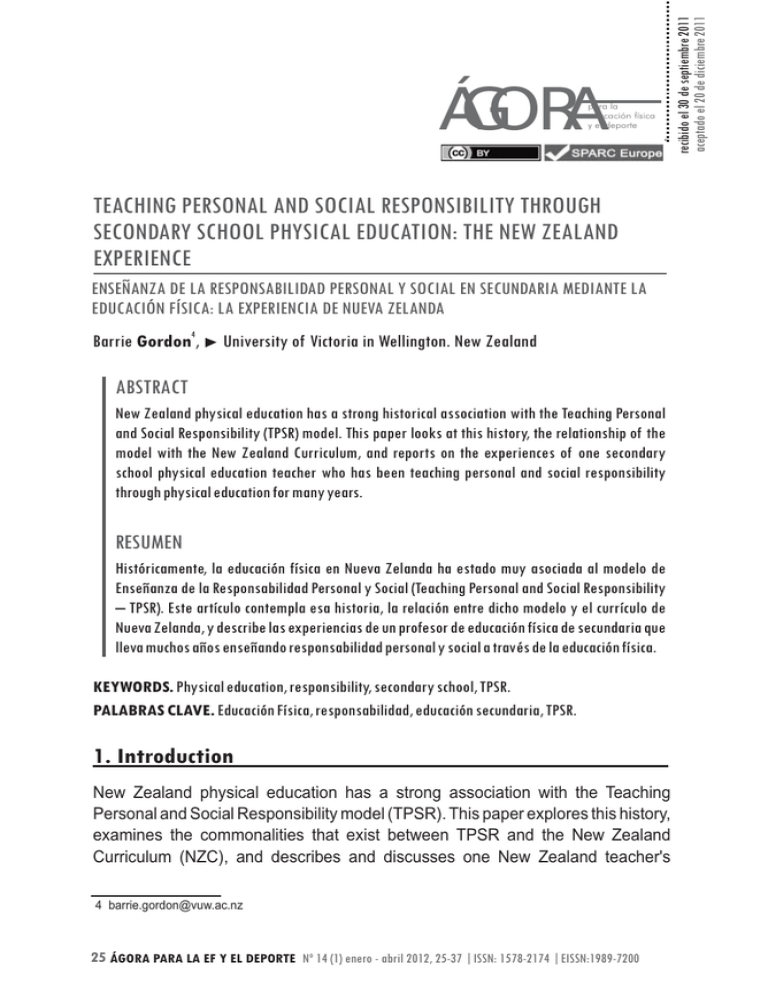
TEACHING PERSONAL AND SOCIAL RESPONSIBILITY THROUGH SECONDARY SCHOOL PHYSICAL EDUCATION: THE NEW ZEALAND EXPERIENCE ENSEÑANZA DE LA RESPONSABILIDAD PERSONAL Y SOCIAL EN SECUNDARIA MEDIANTE LA EDUCACIÓN FÍSICA: LA EXPERIENCIA DE NUEVA ZELANDA 4 Barrie Gordon , University of Victoria in Wellington. New Zealand ABSTRACT New Zealand physical education has a strong historical association with the Teaching Personal and Social Responsibility (TPSR) model. This paper looks at this history, the relationship of the model with the New Zealand Curriculum, and reports on the experiences of one secondary school physical education teacher who has been teaching personal and social responsibility through physical education for many years. RESUMEN Históricamente, la educación física en Nueva Zelanda ha estado muy asociada al modelo de Enseñanza de la Responsabilidad Personal y Social (Teaching Personal and Social Responsibility – TPSR). Este artículo contempla esa historia, la relación entre dicho modelo y el currículo de Nueva Zelanda, y describe las experiencias de un profesor de educación física de secundaria que lleva muchos años enseñando responsabilidad personal y social a través de la educación física. KEYWORDS. Physical education, responsibility, secondary school, TPSR. PALABRAS CLAVE. Educación Física, responsabilidad, educación secundaria, TPSR. 1. Introduction New Zealand physical education has a strong association with the Teaching Personal and Social Responsibility model (TPSR). This paper explores this history, examines the commonalities that exist between TPSR and the New Zealand Curriculum (NZC), and describes and discusses one New Zealand teacher's 4 [email protected] 25 ÁGORA PARA LA EF Y EL DEPORTE Nº 14 (1) enero - abril 2012, 25-37 |ISSN: 1578-2174 |EISSN:1989-7200 recibido el 30 de septiembre 2011 aceptado el 20 de diciembre 2011 ÁGORA para la educación física y el deporte BARRIE GORDON. TPSR – Secondary School PE – New Zealand. experience of teaching a TPSR-based physical education programme in an urban New Zealand secondary school. Sally (pseudonym), the teacher at the centre of this paper, is an experienced teacher of physical education who has implemented TPSR with her students for over ten years. Before discussing Sally's implementation, it may be useful to describe the New Zealand context, with particular reference to the NZC and the alignment that exists between its goals and the goals of TPSR. New Zealand is a small country, of approximately four million people, situated in the South Pacific. It has a well-established education system that, while initially modelled on the English system, has continually evolved to meet the specific needs of the country. Schooling is compulsory for all children from the ages of five to sixteen, with students having the option of staying on to complete their secondary school education. Graduation from secondary school generally occurs when students are approximately 18 years of age. 2. New Zealand Curriculum Teaching and learning within the New Zealand system is strongly guided by the NZC (Ministry of Education, 2007) which has as its principal function “to set the direction for student learning and to provide guidance for schools as they design and review their curriculum” (p. 6). All schools in New Zealand are required to follow the NZC making it an important and influential document. The overall vision for the document is for the New Zealand educational system to produce young people who are “confident, connected, actively involved and lifelong learners” (p. 7). In order to support the achievement of this vision the document identifies seven values, five key competencies and eight learning areas, all of which should be included in every teaching and learning programme for students. It is interesting to note that an examination of the values, key competencies and the learning area of health and physical education establishes that there is a clear alignment between the intentions of the NZC and the goals of TPSR. The seven underpinning values identified in the document are expected to “be encouraged, modelled and explored” by all students (Ministry of Education, 2007, p. 10). Of particular relevance to TPSR are the values of integrity and respect. Integrity is described as students' “being honest, responsible, accountable and acting ethically … while the value of respect includes [showing the ability] to respect themselves, others and human rights” (p.10). 26 ÁGORA PARA LA EF Y EL DEPORTE Nº 14 (1) enero - abril 2012, 25-37 BARRIE GORDON. TPSR – Secondary School PE – New Zealand. Also described in the curriculum are the “five key competencies of: thinking, using language, symbols and texts, managing self, relating to others and participating and contributing” (p. 12). The key competencies are not conceptualised as being separate or stand alone but it is intended that they be integrated throughout the whole curriculum. The importance allocated to the key competencies is shown by their being described as “the key to learning in every learning area” (italics added) (p. 12). In relation to the developing of the competencies, it is expected that this will occur in social situations with students adopting and adapting them as they see them used and valued by others around them. In describing how the key competencies continue to develop, the document states that this occurs over time and is “shaped by interactions with people, places, ideas and things. Students need to be challenged and supported to develop them in contexts that are increasingly wide-ranging and complex” (p. 12). In considering these factors it is apparent that quality physical education programmes offer the opportunities for this to occur. Of the five key competencies, three –managing self; relating to others; and participating and contributing– are particularly pertinent to TPSR: Students who can manage themselves are enterprising, resourceful reliable and resilient. They establish personal goals, make plans, manage projects, and set high standards. They have strategies for meeting challenges. They know when to lead, when to follow and when and how to act independently (ibid.: 12). The key competency of relating to others is about: ... interacting effectively with a diverse range of people in a variety of contexts. This competency includes the ability to listen actively, recognise different points of view, negotiate and share ideas… Students who relate well to others are aware of how their words and actions affect others (ibid.: 12). Participating and contributing concerns the capacity of students to be actively involved in their communities: … [this] includes a capacity to contribute appropriately as a group member, to make connections with others, and to create opportunities for others in the group … to have a sense of belonging and the confidence to participate in new contexts … to understand the importance of balancing rights, roles and responsibilities (ibid.: 13). Nº 14 (1) enero - abril 2012, 25-37 ÁGORA PARA LA EF Y EL DEPORTE 27 BARRIE GORDON. TPSR – Secondary School PE – New Zealand. The health and physical education learning area within the NZC is focused on the “well-being of the student, others and of the wider society through learning in health-related and movement contexts” (p. 22). The document states that students who study health and physical education: … reflect on the nature of well-being and how to promote it. As they develop resilience and a sense of personal and social responsibility, they are increasingly able to take responsibility for themselves and contribute to the well-being of those around them, of their communities, of their environments [including natural environments], and of wider society (ibid.: 22). The direct identification of developing personal and social responsibility as outcomes of participation in health and physical education is a clear message to teachers that TPSR should be considered as a legitimate pedagogical approach to the teaching of physical education. 3. TPSR influence on New Zealand PE (Sally's experiences) TPSR has had a presence in, and influence on, New Zealand physical education for a number of years. In 2001 its founder, Don Hellison, was invited to visit New Zealand by Physical Education New Zealand to introduce TPSR to New Zealand physical educators. The visit proved to be the catalyst that led to a number of physical education teachers introducing TPSR into their own professional practice. The initial visit was followed in 2004 by a three-day workshop run in New Zealand by Hellison and David Walsh which attracted 30 teachers, the majority of whom were already using the model in their teaching. The degree to which these initiatives has led to TPSR becoming established in New Zealand physical education practice is shown in a recent survey (Gordon, 2011) of New Zealand secondary schools (N 370) in which 70 of 148 responding schools reported using TPSR in their physical education programmes. The teachers using TPSR also indicated that they generally had a long-term commitment to the model with 69.7% reporting they had used TPSR for over two years while 37.8% indicated they had been using the model for over five years. Previous research (Gordon, 2010a) has also identified that TPSR is taught as a pedagogical approach to the teaching of physical education in all six of the major New Zealand universities' initial teacher education programmes. This means that all beginning physical education teachers will have some level of knowledge and understanding of TPSR when they begin their teaching careers. 28 ÁGORA PARA LA EF Y EL DEPORTE Nº 14 (1) enero - abril 2012, 25-37 BARRIE GORDON. TPSR – Secondary School PE – New Zealand. This article examines the experiences of Sally, a physical education specialist teaching in a New Zealand secondary school, in teaching a physical education programme based on TPSR. For the first two years at Sally's school, students are timetabled for two one-hour physical education lessons per week. Classes are coeducational with the students remaining together for a number of the core compulsory subjects. After the initial two years of compulsory physical education the subject becomes optional for the remainder of their schooling. Sally was initially introduced to TPSR as part of her university programme of teacher preparation. This background led her to trial the model in her second year of teaching with a class she was having difficulties managing. The introduction of TPSR as a means towards managing student behaviour is not an unusual occurrence for teachers (Mrugala, 2002). Sally was clear, however, that while the motivation was initially management she had a strong philosophical alignment with TPSR humanistic underpinnings and that she was quickly sold on its ability to humanise her classroom. As a result of the success of this initial implementation, Sally continued to use TPSR over the following years. In her fourth year of teaching Sally completed a post-graduate paper on TPSR with the intention of expanding her theoretical understanding of the model and being introduced to relevant research. This was a successful process and she found that the extra depth of understanding helped her as she sought to implement TPSR, while battling through the challenges of her own “swamp of practice”. When discussing her experiences of working with TPSR it became clear that an important underpinning to Sally's teaching was the high level of commitment that she gives to the teaching of personal and social responsibility. While this may appear a relatively obvious statement, the level of priority that teachers actually give TPSR in the reality of their teaching practice has a strong impact on how and what is taught. This commitment is not measured by what is written in lesson plans or articulated in discussions but is demonstrated in the relationships established between teacher and students, the ways that classes are taught, and in the expectations held for students' behaviour. Sally was fully aware of the twin goals (Hellison, 2003) of achieving the outcomes related to both TPSR and the physical education curriculum and was committed to achieving both. What was noticeable, however, was that when making pedagogical decisions Sally would often prioritise the goals related to TPSR over those of the physical education curriculum. Nº 14 (1) enero - abril 2012, 25-37 ÁGORA PARA LA EF Y EL DEPORTE 29 BARRIE GORDON. TPSR – Secondary School PE – New Zealand. There are a number of examples given which demonstrated how the need to achieve TPSR related outcomes had a direct impact on the pedagogy and content of the physical education programme. Sally talked, for example, about the simple warm-up that she used in her gymnasium-based lessons. The warm-up involved running six lengths of the gymnasium, followed by two lengths of skipping, hopping and jumping. The class then gathered in a circle and went through a set series of stretches. This warm-up was repeated every lesson and as a warm-up activity Sally readily described it as lacking variation and excitement. It was deliberately run in this way, however, because its repetitive and simple nature allowed students to slowly begin to take a lead in different aspects of the warm-up. As “the whole class knows what they are doing and what is next, whoever leads the class is guaranteed success,…, they are not going to fail in front of their peers”. This supported situation was used as an introductory activity towards students developing responsibility and taking a leadership role within the class. After many years of using TPSR in her physical education programme, Sally has developed a process of introducing and developing the model that works well for her. In the first of the four terms in the school year the classes are run in a fairly strict and teacher directed manner. During this time Sally concentrates on developing two aspects that will be crucial for the successful implementation of TPSR later in the year. The first concerns developing a shared vocabulary and understanding of key words: I talk a lot about participation, self-control, responsibility… I pick my key words and use them regularly and often so that students know what I mean by them. But I also know what they interpret as participation [for example], so we both understand each other… and I know that they know what I am talking about, that I haven't missed the boat there. The second process involves the gradual introduction of a lesson structure and of specific activities that help the transition of students into a more fully TPSR-based programme later in the year. The warm-up mentioned previously is a good example of the process. Students would be already helping lead this part of the lesson when discussions around responsibility and taking leadership roles within the class began as part of the introduction of TPSR. Having this concrete example in place means that taking a leadership role during warm-ups is not considered out of the ordinary and offers a relatively painless way to help develop student understanding and confidence. 30 ÁGORA PARA LA EF Y EL DEPORTE Nº 14 (1) enero - abril 2012, 25-37 BARRIE GORDON. TPSR – Secondary School PE – New Zealand. As the year progresses the students are introduced to more and more detail about TPSR and the ways in which they experience physical education changes as the classroom pedagogy becomes more and more aligned with TPSR. The structure of the lessons is steadily modified until students are generally following the traditional TPSR format. This format involves an introductory awareness talk/activity, the activity part of the lesson taught in a manner that supports learning around TPSR and a group discussion at the end of the lesson. During this discussion students reflect as a group on what has occurred in the class and then on their own behaviours as individuals (Hellison, 2011). Sally commented that she considered the discussions were an important part of her programme and that she made a strong commitment to them. This commitment meant that at times, if she felt it was important, she would continue with the discussions until after the end of the lesson. In general, Sally expected that by the final term the classes would be functioning at a level whereby the students had a central role in the planning and implementation of the physical education programme. As a result, her role became progressively less concerned with being out the front of the class and more one of facilitation and support. The changes in her pedagogical approaches meant that in many ways her teaching became more complex and multi-faceted as the year progressed. While not obviously and visibly “in charge” in the more traditional sense, Sally was actively engaged with students at a variety of levels. A central philosophical underpinning of Sally's physical education programme is that of offering students choices and of their accepting logical consequences for the choices they make. One example involved a year 10 class (14 and 15 yearolds) who had one lesson per week in the gymnasium, a time designated in the physical education programme as rugby and soccer. The class was asked to make a choice about what they wanted to do in this class. The majority of the boys selected rugby while a small number of boys selected practising soccer. Among the girls one small group selected practising netball while a second group of reluctant participants was unsure. So the discussion was 'what do you want to do? We have a space inside in the pavilion which you can use but whatever you choose needs to have a physical activity element'. So they decided to do walking and self-defence. One of the girls did Tae Kwon Do and so she organised the programme. And the funny thing was that she had them running, doing warm-ups and then practising holds and things and they all did it. If I had told them they Nº 14 (1) enero - abril 2012, 25-37 ÁGORA PARA LA EF Y EL DEPORTE 31 BARRIE GORDON. TPSR – Secondary School PE – New Zealand. had to run, stretch, etc., no show. And this included girls who had never done PE and usually spent their PE time doing lines…, two even got interested in running. When choices were given to students it was generally done in a way that included clear parameters, parameters which varied depending on the student's abilities to be responsible and on the context of the programme. Students who were unable to be trusted to work by themselves were given either a very limited, or no, choice. Others who had demonstrated that they were able to be trusted were offered more flexibility. Sally was very clear that the process of moving to students making choices was a careful and structured one whereby students were given more and more control as they showed themselves ready and able to be responsible. For some students there was rapid progress while for others it was a more difficult learning process with successes and failures along the way. A second example that demonstrates how students were treated in different ways depending on their choices is shown by the process that occurred at the start of many lessons. The school had large posters of all six levels (level 0 to level 5) displayed on the gymnasium wall. These posters included a description of the level, examples of associated behaviours and comments on how the levels aligned with the school values. During the awareness activity students were asked to stand next to the poster of the level that they felt they would like to work at or towards for that lesson. As a result of where they chose to stand the students were treated in different ways. Sally explained: So it means that sometimes I can go OK great [level 3] I'll catch up with you later, head off and do your warm-up. Right you guys, if you are operating at level zero it's on my terms so this is what I want you to do. Head off and do it. And this lot right what do we need to work on? And normally the conversation is 'you have picked level 1 which means I need to remind you, give you prompts about some things so what is it ok for me to remind you about today?' And someone will say something like “calling out” and so that's what I will always react to. I don't let it go when they call out because that's our sort of agreement. I'll also often have an individual conversation with a student choosing level 0 or 1 along the lines of 'you tell me what you think is holding you back from raising it to that really good level of participation and I will help you with it.' Along with the availability of choices was the very clear message from Sally that students were responsible for the consequences of the choices they made. When 32 ÁGORA PARA LA EF Y EL DEPORTE Nº 14 (1) enero - abril 2012, 25-37 BARRIE GORDON. TPSR – Secondary School PE – New Zealand. talking about how she reacted to students who, for example, chose to wear inappropriate clothing for PE, she commented: The only thing we do joke about is if they go walking [as part of their PE programme] they have to go past the principal's office, and I say 'you will have to explain to her why you are not wearing the correct gear' [PE clothing] or 'why you think fluffy slippers are appropriate to run around the block'. But that's not my problem. I'm not taking it on board as my problem. [And] if the Head of Department PE asks you it's your problem that you haven't got your correct gear it's actually not mine and I'm not going to fight that one for you. The students were therefore clear that while they had choices available, the consequences of these choices were theirs to deal with. The same philosophy related to the bringing of notes by students to excuse them from participating in physical education. Notes were not accepted and it was the student's responsibility to approach Sally, explain the situation, and to negotiate how they would be involved in the lesson. If the student was sick or injured then they would always have some level of involvement in class. If they had simply forgotten their PE clothing then they participated fully in school clothes: Yep because its their choice [not to bring a change of clothes] and I just say 'well you may smell you poor thing' type of comment because at the end of the day my goal is engaging them in some form of physical activity, but also engaging them in their responsibilities. (So you allow them to go on their walk if they are wearing their school uniform?) Most of them will happily just do it. But it's funny because they tend to always have something. (How can you be in conflict with somebody when you say 'oh, that's alright, you've made your choice'?) Yeah, but it's not an easy option for them. Because I will actually engage in these conversations with them. For some of them, particularly the boys, I think they'd rather just take the party line [bring a change of clothes] just to avoid having the 'so how do you feel about that?' conversation. In TPSR it is often the individual stories that offer the strongest insight into the impact of TPSR. Paul (pseudonym) had been a problematic member of the class from the first day he arrived. His major problem in physical education was a lack of Nº 14 (1) enero - abril 2012, 25-37 ÁGORA PARA LA EF Y EL DEPORTE 33 BARRIE GORDON. TPSR – Secondary School PE – New Zealand. social skills and his consistently inappropriate behaviour. The other students in class were very negative and few would work with him in class unless directly told to by the teacher. One example given concerned a badminton unit where no-one would pair up with him. Finally one student was paired with him because she was the only student which Sally believed could be nice to him for the whole period: And the student came up and said 'I can't do it- I need a break!' And I was like okay I can understand that. But Paul was happy. What he would do is he would just hit – he would head to the other side of the gym and just hit the shuttlecock against the wall (by himself). His normal physical education experience, as described by Sally, was that for the first ten minutes of class he would wind her up and then cause problems with other students in the class. “He would sort of hang around at the sides watching the others. But he wouldn't step in, but they also – when he did step in he would be a bit of a dick and they'd sort of bump him off”. He would then wander around by himself for the rest of the lesson with an occasional foray into other groups which would usually lead to further conflict. During our interview Sally showed a section of a video recording demonstrating how the class was now relating to Paul. In the video a group of boys is teaching Paul a rugby drill involving running and passing the ball in a specific pattern. Paul is the only boy struggling to complete the drill correctly and the video follows the other boys' attempts to teach Paul the drill and to keep him involved. As we watched the video Sally commented: I can't believe what I am seeing, the boys are quite respectful and actually showing him what he needs to know to do it. Given the rest all know it and they are happy for it to fall to bits to help him learn… What interests me is the language they are using with him… they are not directing him, he is actually being brought into the group. This video clip was taken about half-way through the year and was a clear demonstration of the change that was occurring for Paul in his relationships with his classmates. While no formal evaluation of TPSR occurred in Sally's class it was examples such as this that helped sustain her strong belief in the model. The teaching of TPSR within the physical education programme does not occur in a vacuum and its presence has an impact on the wider school community. One problem previously identified by Gordon (2010b) is that of students who are enjoying the way they are treated in physical education, reacting badly to their 34 ÁGORA PARA LA EF Y EL DEPORTE Nº 14 (1) enero - abril 2012, 25-37 BARRIE GORDON. TPSR – Secondary School PE – New Zealand. other teachers who may relate to them in a more “traditional” manner. This is particularly so in secondary schools where a class can take their shared experiences to the next classroom. Sally identified that this was a problem with some students and that it presented a challenge for their other teachers and the students themselves. The discussions held in class around the transfer of responsible behaviour to other contexts was seen as having the potential to alleviate this. One common observation of TPSR in schools (Hellison, 2011) is that many of the students who behave well in TPSR-based physical education programmes are seen as problematic in other areas of the school. As a result TPSR can be seen by outside teachers, including principals, as a potential method of “controlling students”. Because of the “good behaviour” of her classes, Sally was approached by her principal to run a full staff meeting on classroom management. While she did the presentation she was firm that it would not be about classroom management but rather it would be about introducing an alternative way of working with students which had the ability to create an environment in where students could learn to manage themselves better. Her presentation was well received and there was some discussion at the meeting about requiring all teachers to use TPSR in their classrooms. This is a reasonably common reaction in schools where there has been a successful implementation of TPSR. While there are various beliefs about the suitability of full school implementations Sally was clear that she believed that this was not an approach that all teachers should be required to implement. She felt strongly that TPSR should only be used by teachers for whom it made sense and was aligned with their personal philosophies. While the ability of TPSR to moderate student behaviour attracts attention from other teachers, there is also interest at a more fundamental level in its ability to generate learning around the values and key competencies identified in the NZC. These are clearly intended to be taught in schools and schools are required to demonstrate how they are implementing these aspects of the NZC in their practice. In many New Zealand schools, physical education programmes based on TPSR are seen as an example of how the teaching of values and key competencies can be integrated into the teaching of curriculum. As a result of this a number of schools have asked physical education teachers to take leadership roles in helping their colleagues develop successful ways of implementing the requirements of the NZC within their own learning areas. Nº 14 (1) enero - abril 2012, 25-37 ÁGORA PARA LA EF Y EL DEPORTE 35 BARRIE GORDON. TPSR – Secondary School PE – New Zealand. When discussing the use of TPSR, and its relationship to the NZC, Sally felt that in some ways it was a case of the NZC catching up with and validating what she and others had been doing for a number of years. When asked about teaching the values and key competencies she commented that: ...well you see now they [senior management in school] are looking to me as someone whose got, not just that pedagogical understanding… but it's, how do we translate this into our world? And I suppose it's having that – a bit more understanding and knowledgeable about putting this into a practical classroom situation. In many ways Sally is an excellent advertisement for the use of TPSR in physical education. She has used TPSR for a number of years and it has now become ingrained to the stage where it is just “the way she teaches”. The degree to which TPSR has become integrated is demonstrated by the way in which a number of aspects of her practice, while based on TPSR, are implemented without conscious referral to the model. When asked about the use of group discussions at the end of each lesson, for example, she commented “Yes we still do this – the thing is a lot of the stuff you keep promoting, it's so ingrained that I forget that it's [what I do]”. 4. A final comment Sally is still committed to TPSR and is sustained both by the successes she observes and her philosophical beliefs about the importance of teaching students to be more personally and socially responsible. She does not have empiricallybased evidence in evaluating the outcomes of a TPSR based physical education programme but she does have a strong professional belief in its success. This belief is based on many years of using TPSR in her teaching and of observing the impact on her relationships with students and on her students' learning. This is a pedagogical approach that for Sally has truly been “teacher tested”. Despite her advocacy for this way of teaching she is also aware of the pressures and the downsides involved. Even after many years of experience in teaching TPSR she is still challenged by the unpredictability of the classroom context, and the uncertainty of students' responses. When working with TPSR there is of necessity an element of letting go, of trusting in both the students and the process. To let go in this way creates its own pressures which can be stressful at times. While the end result is often spectacular, the journey can be bumpy, but it is still a journey that Sally chooses to embark on each year. 36 ÁGORA PARA LA EF Y EL DEPORTE Nº 14 (1) enero - abril 2012, 25-37 BARRIE GORDON. TPSR – Secondary School PE – New Zealand. References GORDON, B. (2010a) Teaching personal and social responsibility through physical education: An examination of the Teaching Personal and Social Responsibility model when taught in a New Zealand secondary school. Saarbrucken:Germany, LambertAcademic Publishing. GORDON, B. (2010b) An Examination of the Responsibility Model in a New Zealand Secondary School Physical Education Program. Journal of Teaching in Physical Education 29: 21-37. GORDON, B. (2011) Teaching Personal and Social Responsibility in New Zealand Secondary School Physical Education. New Zealand Physical Educator, 44(1): 18-21. HELLISON, D. (2003) Teaching Responsibility Through Physical Education (2nd ed.). Champaign, IL, Human Kinetics. HELLISON, D. (2011) Teaching Personal and Social Responsibilty Through Physical Education (3rd ed.). Champaign :IL, Human Kinetics. MINISTRY OF EDUCATION (2007) The New Zealand Curriculum. Wellington, Learning Media. MRUGALA, K. (2002) Exploritory study of responsibility model practitioners. (Unpublished doctoral dissertation) University of Illinois at Chicago. Nº 14 (1) enero - abril 2012, 25-37 ÁGORA PARA LA EF Y EL DEPORTE 37
